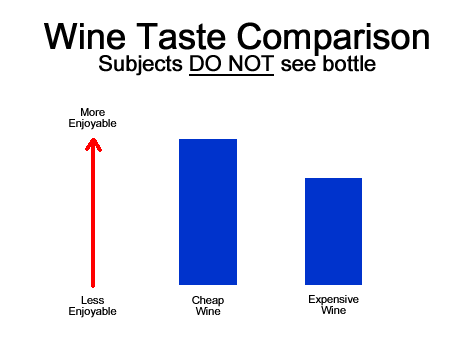Please Your Guests by Fooling Them

Imagine that you are shopping for a few bottles of wine for your next dinner party. You probably aren’t going to buy from the cheapest selections. You don’t want your guests to think you are a cheapskate, or that you have such a low opinion of them that you’d serve them plonk. Besides, you are a Neuromarketing reader, and you know that real quality aside, wines we think are expensive taste better. Most likely, you’ll move away from the cheap stuff and opt for something mid-priced. And, if your guests are particularly important to you, you may choose an even more expensive wine.
Well, there’s good news for wine lovers on a tight budget: it turns out that expensive wine doesn’t always taste better. Peter Martin of the Canberra Times sent a link to an article he wrote with some findings that will surprise a few of you. Can you guess the one circumstance when expensive wine doesn’t beat the cheap stuff?
It turns out that the one time when cheap wine fares about as well as expensive wine is in a blind taste test. In fact, according to Peter’s article, Sunday dollars + sense: Wine experts are on to something, researchers found that on average, people enjoy expensive wines slightly less. Before you rush out the door to stock up on Two Buck Chuck for that dinner party, though, you should be aware that there are a couple of important caveats to this finding. First, the subjects were not professional wine tasters, and their tastes may be more plebeian than your own discriminating palate. Second, because they had no idea what they were tasting, it wasn’t a real-world simulation of what you or your dinner guests might experience (unless you pour your wine from a decanter or otherwise out of view).
To quote Peter’s article,
The findings suggest that if one wine costs ten times as much as another, non-experts will on average rate it 4 points lower on a 100 point scale whereas experts will rate it 7 points higher.
The experts are expert at something. But it appears not to be at predicting what you and I will like.
In fact the study suggests we will be more likely to find what we like if we use their recommendations as a guide for what to steer clear of.
The experts, in this case, were wine critics. They DID rate the much more expensive wines somewhat higher, but their ratings didn’t indicate much about how much most of us would enjoy the wine. And, as Peter notes, the wine critics were able to spot the costly wines, “although still not that much more often than by chance.” Blind taste tests often befuddle even the most experienced wine critics, as when Two Buck Chuck Chardonnay was judged to be the “Best in California” and “Best in Class” at the California State Fair wine competition.
The original research was published in the The Journal of Wine Economics: Do More Expensive Wines Taste Better?
So What About Your Dinner Party?
Let’s graphically summarize the research on wine tasting psychology. (These charts are meant to be generally indicative of the research, not quantitative representations of the findings.) First, this chart shows the effect of the wine’s label on the enjoyment of the wine. Wine that people think is more expensive tastes better, even when measured by brain scans:

Second, here’s what the the blind taste tests described in the Journal of Wine Economics showed – most people rated the cheap wines as tastier when they didn’t know what they were drinking:

So, if you are still trying to decide what to buy for your dinner party, consider your guests. If you have invited a group of wine writers and professional wine tasters, you had better spring for something that’s highly rated (and most likely more expensive). You may not enjoy the wine as much, but there’s a chance that at least some of your well-trained guests will spot the difference. And, of course, if you plop a bottle of Little Penguin in the middle of the table these experts will also know how little you paid for it.
If your guests are regular folks, however, there’s a good chance that the $5 Little Penguin cab will actually taste better to them than a $50 wine – but only if they don’t see the bottle and identify it as an inexpensive wine you can find in every supermarket. So, you have two other choices: choose a wine that seems expensive enough to make your guests find it tasty, or fool them with cheap but pleasant wine that has been disguised in some way. Pour the wine in the kitchen (leave an empty bottle of an expensive vintage on the counter in case someone wanders in unexpectedly), pour the cheap wine into an attractive crystal decanter (as a bonus, a little breathing in the decanting process will improve the taste of cheap reds), or, if you are really diabolical, transfer the cheap stuff into an empty bottle from a much more costly wine. Here’s a representation of the various ways you could serve your wine:

Theoretically, at least, your guests with typical palates will enjoy the wine most if it’s inexpensive but they think it’s expensive.
No, I don’t actually rebottle the wines I serve at dinner. But when even wine experts have difficulty separating cheap from expensive wines, and blind tests show that most people prefer the taste of cheap wines, one could rationalize that a dinner host who did that was maximizing the satisfaction of his guests. He’d be serving the wine that he knew they would find most appealing in a blind test, and further enhancing their satisfaction by convincing them that the wine was a costly vintage. Best of all, he’d have the research to prove it. Maybe we’ve discovered a new field of research: neuro-entertaining. 🙂
